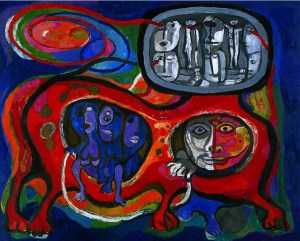BRUNSWICK – This March, the Bowdoin College Museum of Art presents an exhibition that explores the impact of the Space Race, science fiction, and the explosive growth of technological innovation on artists of the Americas from the 1940s to the 1970s. ” Past Futures: Science Fiction, space travel and Postwar Art of the Americas” features over 60 works in a range of media and creative styles—from expressionist paintings and kinetic sculptures to graphite drawings and conceptual pieces. Drawing on works from public and private collections from North and South America, the exhibition investigates how artists from the United States and several Latin American countries interpreted notions of conquest, discovery, and crossing into new territories—both terrestrial and celestial. Curated by Sarah J. Montross, Andrew W. Mellon post-doctoral curatorial fellow at the BCMA, and on view at Bowdoin from March 5 – June 7, “Past Futures” broadens the conversation beyond avant-garde art of postwar Europe, the Soviet Union, and the United States by shining new light on artworks created by Latin American artists at this time, and examining the complex relationships between the American continents during this transformative era.
The works featured in “Past Futures” are presented against the backdrop of mounting Cold War tensions as the United States called for Pan-Americanist economic and political policies that emphasized stronger North and South American solidarity against the spread of communism. Simultaneously, the rise of the “Space Race” gripped international attention, and the science fiction genre flourished in film and literature cultures across the Americas.
“Past Futures” investigates how artists from the United States and several Latin American countries, including Argentina, Chile, and Mexico, navigated these complex political and cultural shifts and showcases their creative reactions to the emergence of new technologies, such as robotics, rocketry, and computer systems.
“Artists practicing in the Americas during the postwar period have an extraordinary, underexplored story to tell,” said Montross. Technological and scientific innovations developed quite differently across the Western hemisphere, and the work in “Past Futures” offers a unique lens to consider inter-American exchanges and divergences related to art, science, and technology.”
Offering an in-depth view of this artistic period, the exhibit is centered on four principle themes: representations of cosmic spaces and otherworldly encounters; the possibilities of space travel through new visual technologies; the dynamics of time travel; and the preoccupation with utopian or dystopian futures. Notable works in the exhibition include:
· Raquel Forner’s painting Astronauta y testigos, televisados (1971), a vibrantly colored painting picturing an encounter between astronauts and mutant beings from outer space; and,
· Gyula Kosice’s La ciudad hidroespacial (1942-1972; ongoing), a visionary multimedia project consisting of small-scale Plexiglas maquettes, architectural diagrams, and writings that detail designs for a new society stationed thousands of feet above the earth’s surface, which conveys the artist’s belief in the future as a site of unrealized and unlimited opportunity.
“Past Futures” provides an exciting opportunity to engage our Museum, College, and broad visiting audiences with art works that spark both the scientific and artistic imagination, and transport us to an era rich with inventive and creative possibilities,” said Anne Collins Goodyear, co-director of the Bowdoin College Museum of Art. “The exhibition, along with its accompanying catalogue and public programs, brings to light a crucial aspect of the postwar period that will strengthen not only our knowledge of these works of art but also our understanding of this complex period of inter-American relations amid the Cold War,” continued Frank Goodyear, co-director of the Bowdoin College Museum of Art.
Published in conjunction with The MIT Press, a fully-illustrated catalogue accompanies the exhibition and includes essays by Sarah J. Montross, as well as Rodrigo Alonso, independent scholar and curator; science fiction scholar Miguel Ángel Fernández Delgado; and Rory O’Dea, an expert on the work of Robert Smithson. The publication will lay groundwork for future research on the works included in the exhibition, as well as American art of the postwar period as a whole.
Major programming related to the exhibition will feature a keynote public lecture by a major visiting scholar, a music performance, as well as gallery talks and film screenings, including:
· “Music at the Museum: Sebastian Back to “2001: A Space Odyssey” – March 5
Presented in conjunction with the opening of “Past Futures,” Bowdoin Artist in Residence George Lopez presents an evening of “Futurist music” and close encounters with the “alien” in the history of musical evolution.
· “Latitude 0’08791: Latin American Artists and Science Fiction” – March 26, 2015
A keynote lecture by Gabriel Pérez-Barreiro, Ph.D., director of the Cisneros Foundation, that will explore the ways in which various artists from Latin America used science and space travel as metaphors for expressing present day realities and imagined futures.
· Film Screening: “Nostalgia for the Light” (2011) – March 31
A film screening of the award-winning documentary exploring the convergence of astronomical observations, pre-Colombian archaeology, and Chile’s tumultuous political history, followed by a panel discussion with Allen Wells, Roger Howell, Jr., professor of history, Sarah Childress, visiting assistant professor of cinema studies, and Sarah Montross.
· “Snapshots of Dust and Time: Astronomy and Visual Art” – April 16
Elise Weaver, laboratory instructor in Bowdoin’s department of physics and astronomy, leads an interdisciplinary discussion about representations of the cosmos in astrophotography and other visual media.
· Artist’s Talk: Saya Woolfalk – April 30
Contemporary artist Saya Woolfalk presents on how science fiction and ethnography have informed her recent multi-disciplinary series, including her creation of the “Empathics,” an invented society of mythological beings who blend racial and ethnic differences, and dissolve the line between humans and plants
The exhibition is generously supported by the Andrew W. Mellon Foundation.



Comments are no longer available on this story